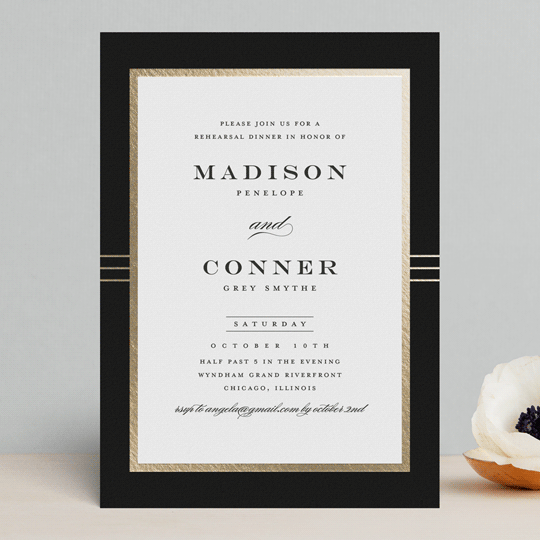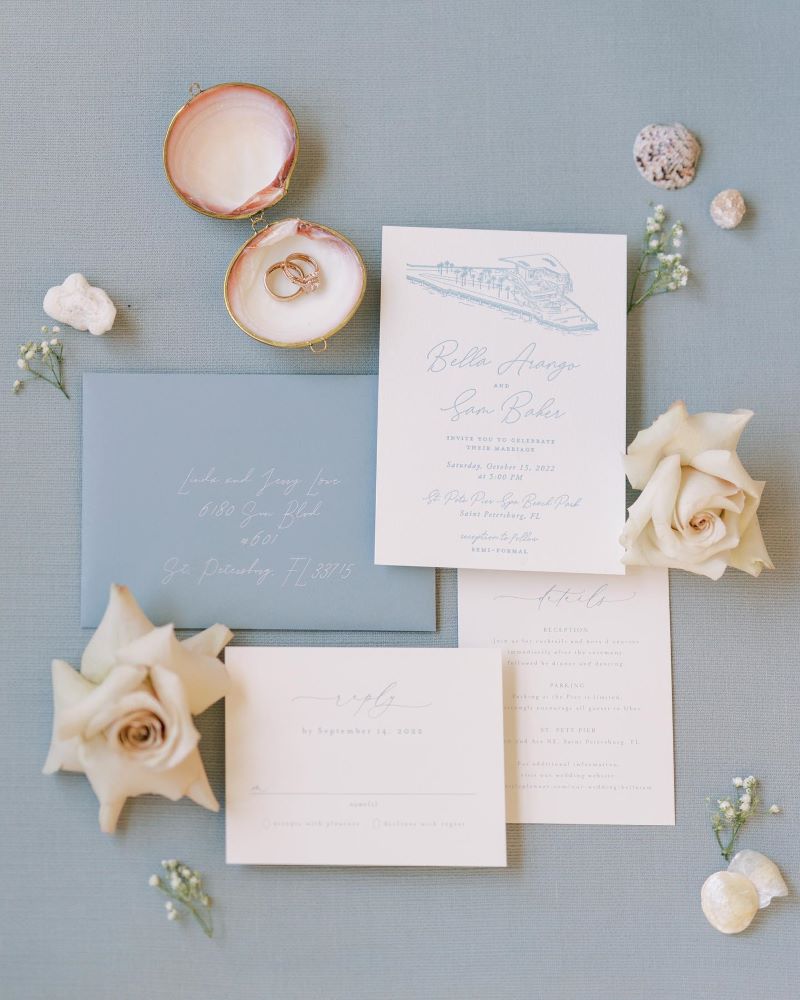Finally! After what is usually many months of planning, the big day is almost here. From selecting a venue and choosing your color palette and theme, to sending out beautiful invitations to your guests - your wedding dreams are about to come to life! A wedding rehearsal is important so that you can work out any scheduling kinks and ensure that everyone involved in the wedding ceremony knows what to do, and when. The below wedding rehearsal guide will serve as a helpful checklist to answer all your questions about wedding etiquette, order of the ceremony, timing, and additional details you’ll want to cover during your practice rehearsal.
Shop Rehearsal Dinner Invitations Shop Wedding Signs Shop Wedding Programs

Image source: Pinterest
Wedding Rehearsal Quick Facts
No need to go digging through countless articles and consulting with numerous wedding couples to get the answers to your pressing wedding rehearsal etiquette questions. We have highlighted the key points below:
What Do You Do At A Wedding Rehearsal?
During the wedding rehearsal, you’ll do a complete practice run (or maybe a few) of your wedding ceremony from start to finish at the actual location of your wedding. This ensures everyone involved in your ceremony knows the order, pacing, when to walk, and where. Think of it like a full dress rehearsal for a major Broadway production, which usually happens the day before opening night.
Who Should Be At The Rehearsal?
Anyone participating in the wedding ceremony should be present at the wedding rehearsal so they know what to do. This usually includes:
- The wedding couple
- Parents
- The wedding party (including child attendants)
- Any readers or special performers
- Ushers (if different from wedding party members)
- The officiant
- Musician (perhaps there is a pianist, harp player, etc.)

Image source: Pinterest
How Long Should It Last?
It’s common to allow an hour for the wedding rehearsal. Read through our wedding rehearsal guide below to understand how this timing is broken down specifically into different segments. Following the rehearsal, you can invite all participants to your rehearsal dinner if that is part of your plans.
What Is The Dress Code?
The dress code for your wedding rehearsal is totally up to you, the couple, to establish the dress code for all participants. Often, there is a dinner immediately following the rehearsal which may require semi-formal attire. But if your wedding vibe is casual, that is great! Just let your participants know in advance on your rehearsal dinner invitations so they’re prepared.
STAY ORGANIZED WITH THIS CHECKLIST OF REHEARSAL TASKS & SAMPLE TIMELINE:
Here is a helpful wedding rehearsal checklist to serve as a sample itinerary and timeline that includes all the typical elements you won’t want to forget as you run through your pre-ceremony trial run. Feel free to tailor this checklist to your rehearsal and wedding style.
Start with a Formal Introduction (5 minutes)
It’s a good idea to start your wedding rehearsal with an introduction of everyone who is involved, especially if some people in your wedding ceremony may be meeting for the first time. Be sure to include and introduce parents, the officiant, your wedding party (including child attendants), and any readers or performers.
Instruct the Ushers (5 minutes)
Oftentimes, the groomsmen will serve as ushers or program distributors before the ceremony begins. Some couples ask additional people to serve in these positions. Regardless, it’s important to communicate with your ushers and walk them through where you want them to stand to greet guests, how you would like them to accompany guests to their chairs, or direct guests to a certain side of the aisle, if you choose. Now is the time to share any special information they should share with guests. Make sure they understand that they should be at the wedding venue before any other guests.

Image source: Pinterest
Time the Music Correctly (5 minutes)
Whether you are having a live musician or recorded music playing over speakers during your wedding ceremony, now is the time to make sure your music is timed as you would like. Designate who will be pushing the play button on a recording, or signaling the musician(s) to start playing. It’s also just as important to know when the music should stop. Do you want the song to finish regardless of if everyone is in their place or should it fade out quietly so you can continue the ceremony? Do you even have a processional song selected? Make these decisions now and communicate with appropriate parties.
Practice the Processional Order (15 minutes, run through twice)
The processional is the entrance to the wedding ceremony. Depending on what type of ceremony you have chosen, the order of the wedding processional may vary slightly. For example, here is the processional order for a traditional Christian ceremony:
- Officiant
- Groom
- Best Man
- Groomsmen
- Bridesmaids
- Maid of Honor / Matron of Honor
- Flower Girl and Ring Bearer
- Bride and Father of the Bride
If you have a wedding planner or day-of coordinator, they’ll usually be positioned at the ceremony entrance to instruct the wedding party when to enter. Once at the end of the aisle, the wedding party should be lined up along either side of the couple. If you have young child attendants, be sure to determine if a specific person should stand at the end of the aisle to encourage them, and where they should go once they reach the end of the aisle.
Practice the processional entrance to music so that everyone can be comfortable with the pace, their cues, and where to go, when. You may want to do a couple of run-throughs if you have young attendants.

Image source: Pinterest
Practice Readings (10 minutes)
After you’ve nailed down the processional, the officiant should review how he or she will lead the ceremony. This will be the time for any readers to practice their readings aloud, at the designated location, and using a microphone if one will be used for the ceremony. Gauge their speed and volume and have them practice more than once, if needed to be comfortable. Advise each reader to bring a printed copy of their reading just in case.
Rehearse any Special Movements for the Maid of Honor and Best Man
If you have special requests for the Maid / Matron of Honor or the the Best Man, be sure to communicate these requests, the cues, and have the responsible individuals practice. An example would be asking the Maid / Matron of Honor to organize the bride’s dress once she’s at the altar, or asking the Best Man to present the rings for the ring exchange.
Practice Recessional Order (10 minutes)
Following the first kiss as a married couple, the end of the ceremony will be signaled by the recessional. This is usually in the reverse order of the processional (the walking in at the beginning of the wedding ceremony). The married couple will exit first, followed by pairs of the wedding party from closest to the couple to farthest from the couple. Here is also where you’ll want to designate if you’d like your ushers to release guests to a receiving line, and if you’d like your parents, grandparents, or any other specific people to leave the ceremony first before the remainder of your guests. Haven’t figured out the perfect song to feature? Review our list of top recessional songs.
Final Q&A (5 minutes)
After you’ve done a practice run (or a few), bring your rehearsal group back together to see if anyone has questions. Now is also a good time to cover when and where they should meet for the actual wedding.

Image source: Pinterest
Thank You’s, Final Instructions, and Invitation Reminder for Rehearsal Dinner (5 minutes)
Congrats! You’ve finished your wedding rehearsal and hopefully feel prepared and comfortable for how your actual wedding ceremony will take place. Remember, you attend this rehearsal so you can be less stressed on your big day!
If you are hosting a rehearsal dinner or welcome gathering immediately following your wedding rehearsal, make sure to communicate where it is, when it is, and how to get there with all your rehearsal participants. Review our Wedding Rehearsal Dinner Guide for tips, invitation etiquette, and dinner ideas.

“Delicate Edge”, designed by Baumbirdy
This wedding rehearsal checklist, sample timeline, and collection of helpful wedding rehearsal etiquette tips should give you a starting point to tailor your specific practice run. Typically an hour is planned for the wedding rehearsal, and often the rehearsal is immediately followed by the rehearsal dinner or welcome party so that everyone can easily progress from the rehearsal to the dinner. Be sure to give your wedding party plenty of advance notice that they will need to attend the rehearsal. Provide the location and start time so that they can arrange travel plans and/or work schedules in accordance.













